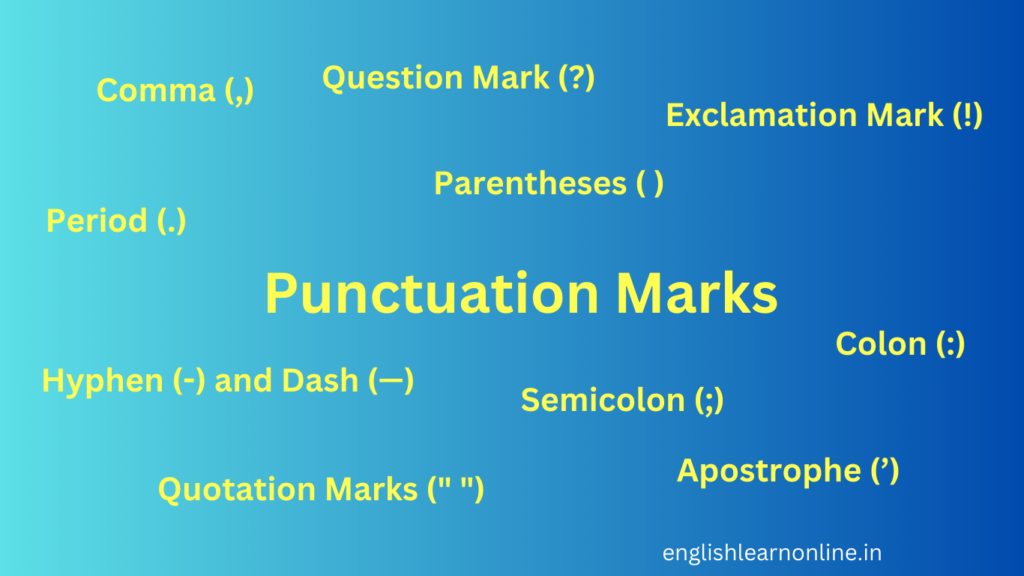Introduction
Punctuation is an essential part of writing. It helps us organize our thoughts, clarify meaning, and make our sentences easy to read. Imagine reading a paragraph without any punctuation—it would be confusing and difficult to understand! Whether you’re writing an email, an essay, or even a social media post, using the right punctuation marks ensures your message is clear and effective.
In this guide, you’ll learn about different punctuation marks, their uses, and how to avoid common mistakes. By the end, you’ll feel more confident in using punctuation correctly in your writing.
What Are Punctuation Marks?
Punctuation marks are symbols used in writing to separate ideas, clarify meaning, and make sentences easier to read. They help us understand where a sentence starts and ends, when to pause, and how different parts of a sentence relate to each other.
Imagine reading a paragraph without any punctuation—it would be confusing! Punctuation marks, like commas, periods, question marks, and exclamation points, give structure to our sentences. They guide the reader and ensure the message is clear.
In short, punctuation marks are like traffic signals in writing. They tell us when to stop, slow down, or emphasize a point. Using them correctly makes your writing more professional and easy to understand.
For example, look at these two sentences:
- Let’s eat, Grandma! (You’re inviting Grandma to eat.)
- Let’s eat Grandma! (This sounds like you’re planning to eat Grandma! )

The 10 Essential Punctuation Marks and Their Usage
Punctuation marks are like road signs for sentences—they guide readers on when to pause, stop, or understand the tone of a sentence. Let’s go over 10 important punctuation marks and how to use them correctly.
1. Period (.)
Used to end a sentence.
- Example: I love reading books.
2. Comma (,)
Used to separate ideas, items in a list, or after introductory words.
- Example: I bought apples, bananas, and oranges.
3. Question Mark (?)
Used at the end of a question.
- Example: Where are you going?
4. Exclamation Mark (!)
Used to show excitement, surprise, or strong emotions.
- Example: That was an amazing performance!
5. Quotation Marks (” “)
Used to show direct speech or a quote.
- Example: She said, “I will call you later.”
6. Apostrophe (‘)
Used for contractions or to show possession.
- Example: It’s a beautiful day. (contraction)
- Example: This is Sarah’s book. (possession)
7. Colon (:)
Used before a list, explanation, or to introduce something important.
- Example: There are three primary colors: red, blue, and yellow.
8. Semicolon (;)
Used to connect closely related sentences or separate list items with commas.
- Example: I have a big test tomorrow; I need to study.
9. Parentheses ( )
Used to add extra information.
- Example: My sister (who lives in Canada) is visiting next week.
10. Hyphen (-) and Dash (—)
A hyphen connects words, while a dash adds emphasis.
- Example (Hyphen): This is a well-written article.
- Example (Dash): I love pizza—especially with extra cheese!
Quick Practice: Test Your Understanding
Let’s see how well you understand punctuation! Try these simple exercises and check your answers at the end.
1. Add the missing punctuation marks:
a) i cant believe you ate my sandwich
b) She said I will meet you at the park at 5 pm
c) My favorite fruits are apples oranges bananas and grapes
d) This is my sisters book not yours
e) Wow that was an incredible performance
2. Choose the correct punctuation mark (., ?, !, 🙂
a) What time will you be home __
b) I have three hobbies __ reading, painting, and hiking
c) That movie was amazing __
d) She loves to read__ her favorite book is “Pride and Prejudice”
3. Fix the incorrect punctuation in these sentences:
a) The dog chased its tail; and barked loudly.
b) “I love this book”! she exclaimed.
c) My brothers car is parked outside.
Answers:
1. Add the missing punctuation marks:
a) I can’t believe you ate my sandwich!
b) She said, “I will meet you at the park at 5 p.m.”
c) My favorite fruits are apples, oranges, bananas, and grapes.
d) This is my sister’s book, not yours.
e) Wow! That was an incredible performance.
2. Choose the correct punctuation mark:
a) What time will you be home?
b) I have three hobbies: reading, painting, and hiking.
c) That movie was amazing!
d) She loves to read; her favorite book is “Pride and Prejudice.”
3. Fix the incorrect punctuation:
a) The dog chased its tail and barked loudly.
b) “I love this book!” she exclaimed.
c) My brother’s car is parked outside.
FAQs About Punctuation (With Tips)
1. Why is punctuation important in writing?
Punctuation helps clarify meaning, making sentences easier to read and understand. Without proper punctuation, sentences can be confusing or misleading.
Tip: Read your sentences out loud—if you pause, you likely need a comma or another punctuation mark!
2. What is the difference between a colon (:) and a semicolon (;)?
A colon introduces a list, explanation, or example (e.g., “I have three pets: a dog, a cat, and a parrot”).
A semicolon connects two related sentences or separates items in a complex list (e.g., “She loves coffee; he prefers tea”).
Tip: Use a colon when you’re introducing something. Use a semicolon when linking two related sentences.
3. When should I use an apostrophe (’)?
Apostrophes show possession (e.g., “John’s book”) or replace missing letters in contractions (e.g., “can’t” for “cannot”).
Tip: Never use an apostrophe for plurals (❌ “apple’s” instead of ✅ “apples”).
